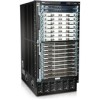Dell PowerConnect J-8216 Hardware Guide - Page 108
Calculating the J-EX8200 Switch Fiber-Optic Cable Power Margin
 |
View all Dell PowerConnect J-8216 manuals
Add to My Manuals
Save this manual to your list of manuals |
Page 108 highlights
Dell PowerConnect J-Series J-EX8216 Ethernet Switch Hardware Guide -15 dBm - (-28 dBm) = 13 dBm Related • Calculating the J-EX8200 Switch Fiber-Optic Cable Power Margin on page 92 Documentation • Optical Interface Support in J-EX8200 Switches on page 51 • Understanding J-EX8200 Switch Fiber-Optic Cable Signal Loss, Attenuation, and Dispersion on page 78 Calculating the J-EX8200 Switch Fiber-Optic Cable Power Margin Calculate the link's power margin when planning fiber-optic cable layout and distances to ensure that fiber-optic connections have sufficient signal power to overcome system losses and still satisfy the minimum input requirements of the receiver for the required performance level. The power margin (P ) is the amount of power available after M attenuation or link loss (LL) has been subtracted from the power budget (P ). B When you calculate the power margin, you use a worst-case analysis to provide a margin of error, even though all the parts of an actual system do not operate at worst-case levels. A power margin (P ) greater than zero indicates that the power budget is sufficient M to operate the receiver and that it does not exceed the maximum receiver input power. This means the link will work. A (P ) that is zero or negative indicates insufficient power M to operate the receiver. See the specification for your receiver to find the maximum receiver input power. Before you begin to calculate the power margin: • Calculate the power budget. See "Calculating the J-EX8200 Switch Fiber-Optic Cable Power Budget" on page 91. To calculate the worst-case estimate for the power margin (P ) for the link: M 1. Determine the maximum value for link loss (LL) by adding estimated values for applicable link-loss factors-for example, use the sample values for various factors as provided in Table 43 on page 92 (here, the link is 2 km long and multimode, and the (P ) is 13 dBm): B Table 43: Estimated Values for Factors Causing Link Loss Link-Loss Factor Estimated Link-Loss Value Sample (LL) Calculation Values Higher-order mode losses (HOL) Modal and chromatic dispersion • Multimode-0.5 dBm • Single mode-None • Multimode-None, if product of bandwidth and distance is less than 500 MHz/km • Single mode-None • 0.5 dBm • 0 dBm • 0 dBm • 0 dBm 92















